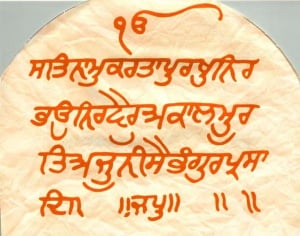Template:Today's featured article: Difference between revisions
From SikhiWiki
Jump to navigationJump to search
Navroopsehmi (talk | contribs) |
|||
| Line 7: | Line 7: | ||
'''[[Mool Mantar|....Continued]]''' | '''[[Mool Mantar|....Continued]]''' | ||
Revision as of 20:55, 18 May 2005
The Mool Mantar
The Mool Mantar is the most important composition contained within the Sri Guru Granth Sahib; it is the basis of Sikhism. It’s importance is emphasised by the fact that it is the first composition to appear in the SGGS and that it appears before the commencement of most of the Raags within the SGGS.
The Mool Mantar is said to be the first composition uttered by Guru Nanak Dev ji upon enlightenment at the age of 30. Being the basis of Sikhism it encapsulates the entire theology of Sikhism, and as a result, it is also the most difficult composition to fully understand. The proceeding Japji Sahib and the rest of the SGGS totalling 1430 pages, are efforts to explain that which is contained within the Mool Mantar.

